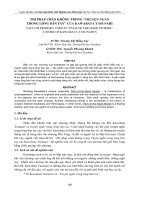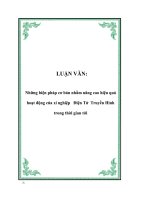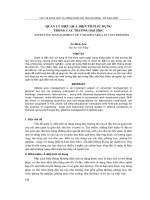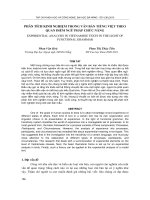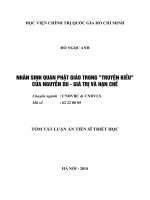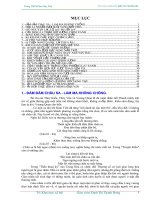Dịch điển tích truyện kiều trong ba bản dịch của vladislav zhukov michael counsell và huỳnh sanh thông
Bạn đang xem bản rút gọn của tài liệu. Xem và tải ngay bản đầy đủ của tài liệu tại đây (1.27 MB, 64 trang )
VIETNAM NATIONAL UNIVERSITY, HANOI
UNIVERSITY OF LANGUAGES AND INTERNATIONAL STUDIES
FACULTY OF ENGLISH LANGUAGE TEACHER EDUCATION
GRADUATION PAPER
TRANSLATION OF ALLUSIONS IN THREE
ENGLISH VERSIONS OF TRUYỆN KIỀU
BY VLADISLAV ZHUKOV, MICHAEL COUNSELL
AND HUỲNH SANH THÔNG
Supervisor : Vương Thị Thanh Nhàn
Student
: Vương Minh Thu
Course
: QH2011.F1.E20
Hanoi, 2015
ĐẠI HỌC QUỐC GIA HÀ NỘI
TRƯỜNG ĐẠI HỌC NGOẠI NGỮ
KHOA SƯ PHẠM TIẾNG ANH
KHĨA LUẬN TỐT NGHIỆP
DỊCH ĐIỂN TÍCH TRUYỆN KIỀU TRONG
BA BẢN DỊCH CỦA VLADISLAV ZHUKOV,
MICHAEL COUNSELL
VÀ HUỲNH SANH THÔNG
Giáo viên hướng dẫn : Vương Thị Thanh Nhàn
Họ tên sinh viên : Vương Minh Thu
Khóa
: QH2011.F1.E20
HÀ NỘI, 2015
I hereby state that I: Vương Minh Thu, QH2011.F1.E20, being a candidate
for the degree of Bachelor of Arts (TEFL) accept the requirements of the
College relating to the retention and use of Bachelor’s Graduation Paper
deposited in the library.
In terms of these conditions, I agree that the origin of my paper deposited
in the library should be accessible for the purposes of study and research,
in accordance with the normal conditions established by the librarian for
the care, loan or reproduction of the paper.
Signature
ACKNOWLEDGEMENT
I owe the success of this research to the following people without whom
this research could not have been finished.
Firstly, I wish to express my sincerest gratitude to my supervisor, Ms.
Vương Thị Thanh Nhàn for her invaluable help, insightful guidance and
supportive encouragement throughout the study and beyond.
I also take this chance to express my special thanks to Ms. Nguyễn Thị
Cẩm Linh for her great help with important materials. My completion of this
study would not have been satisfactory without her support.
Lastly, my most heartfelt thanks would go to my parents who are always
my source of strength and motivation throughout the time.
ABSTRACT
Translating allusions is a great challenge in poem translation, especially in a
classic work as Truyện Kiều. So far, there have been a large number of studies
on Truyện Kiều’s translations but those on the translation of allusions in this
work are quite limited. With three English versions of Truyện Kiều by
Vladislav Zhukov, Michael Counsell and Huỳnh Sanh Thông, this research was
conducted to shed light on the strategies to translate allusions, as well as to
compare the level of faithfulness, clarity and naturalness of the translation in
these versions. Document analysis and interviews were adopted as instruments
to collect data. The final outcomes indicate the prominent use of adaptive
replication and replacement as the major strategies to translate, respectively,
proper-name allusions and key-phrase allusions. The result from both fixedresponse interviews and open-ended interviews reveals noticeable differences
among the translations in three chosen versions. These differences are reasoned
out as the diverse in translators’ aims and approaches. Sacrificing a certain
degree of faithfulness, Counsell’s translation is the clearest and the most
natural translation with rhymes and the omission of many allusions. Zhukov’s
translation is considered beautiful and artistic but not clear and difficult to
understand. The translation which equally satisfies all criteria is Huỳnh’s.
Recommendations for further studies are provided.
CONTENT
Page
Acknowledgement
i
Abstract
ii
List of figures, tables, and abbreviations
v
Chapter 1: Introduction
1.1.
Statement of the problem and the rationale for the study
1
1.2.
Aims of the study and research questions
3
1.3.
Significance of the study
3
1.4.
Scope of the study
4
1.5.
Organization of the study
4
Chapter 2: Literature Review
2.1.
Translation overview
5
2.1.1. Poetry translation
5
2.1.2. The criteria for Translation Quality Assessment
5
2.2.
7
Allusion
2.2.1. Definitions
7
2.2.2. Classifications of allusion
9
2.3.
11
Translation of allusions
2.3.1. Retentive strategies
11
2.3.2. Modifying strategies
12
2.4.
13
Allusions in Truyện Kiều
Chapter 3: Methodology
3.1.
Sampling
14
3.1.1. Selection of three translated versions
14
3.1.2. Selection of the allusions
15
3.2.
16
Data collection methods and procedures
3.2.1. Document analysis
16
3.2.2. Interviews
16
3.3.
18
Data analysis method and procedures
Chapter 4: Findings and Discussion
4.1.
The strategies were used to translate allusions into English in
19
Zhukov’s, Counsell’s and Huỳnh’s translation of Truyện Kiều
4.2.
The faithfulness to the original, the clarity and the naturalness
29
of the translation of ten key-phrase allusions selected
Chapter 5: Conclusion
5.1.
Summary of findings
5.1.1. The strategies used in translating allusions
35
35
5.1.2. The level of faithfulness, clarity and naturalness in versions by 36
Vladislav Zhukov, Michael Counsell and Huỳnh Sanh Thông
5.2.
Limitations of the study
36
5.3.
Recommendations for further studies
37
References
Appendices
LIST OF ABBREVIATIONS
KP
Key-phrase
PN
Proper-name
ST
Source text
TT
Target text
LIST OF TABLES AND FIGURES
Table 2.1
The category of allusions (Leppihalme, 1997)
10
Table 4.1
The strategies used to translate proper-name allusions
19
Table 4.2
The strategies used to translate key-phrase allusions
23
Figure 4.1
The strategies used to translate proper-name allusions 20
in Truyện Kiều by Vladislav Zhukov, Michael Counsell
and Huỳnh Sanh Thông
Figure 4.2
The strategies used to translate key-phrase allusions in 23
Truyện Kiều by Vladislav Zhukov, Michael Counsell
and Huỳnh Sanh Thông
Figure 4.3
The proportion in the usage of metaphor and non- 24
allusive phrase as a replacement in translating keyphrase allusions by Vladislav Zhukov, Michael Counsell
and Huỳnh Sanh Thông
The faithfulness, clarity and naturalness of ten translated 29
allusions in Zhukov’s, Counsell’s and Huỳnh’s
translation
Figure 4.4
Figure 4.5
The faithfulness, clarity and naturalness of ten translated 33
allusions in Zhukov’s, Counsell’s and Huỳnh’s
translation
CHAPTER 1: INTRODUCTION
This initial chapter states the problem and the rationale of the study,
together with the aims, objectives and the scope of the whole paper. Above all,
it is in this chapter that the research questions are indentified to work as clear
guidelines for the whole research.
1.1.
Statement of the problem and rationale for the study
Since its birth in the end of 18th century, Truyện Kiều has been likened to a
gem of Vietnamese literature, become its best representative and “the most
widely revered and constantly quoted work in the whole of Vietnam’s classic
literature” (Henry, 2008, p. 240). So far, Truyện Kiều has been translated into
more than 20 languages with a series of versions in each one (International
workshop on Nguyen Du, 2014). For instance, there have been at least fifteen
French versions of Truyện Kiều with the first translation dated back to 1884. In
English, since 1963, there have been about ten versions of Truyện Kiều by a
number of translators, namely Lê Xuân Thủy, Huỳnh Sanh Thông, Michael
Counsell, Vladislav Zhukov, Charles Beroit and so on (Hoàng, 2008). These
translations are large in quantity and diverse in quality, creating an abundant
source of materials for translators and linguistic researchers. Accordingly, the
number of studies on Truyện Kiều’s translations are also enormous and their
findings are remarkable. Nguyễn and Phan (2014) affirm that “unit – shifts is
the most used procedure and intra- system –shifts is the least used procedure in
both English versions by Michael Counsell and Huỳnh Sanh Thông”;
meanwhile, in the study on expressions of the villains in Truyện Kiều and their
equivalence in three translations by Lê Xuân Thủy, Lê Cao Phan and Huỳnh
Sanh Thông, Võ (2012) pointed out that literal translation is most employed to
address cultural factors such as Sino-Vietnamese, dialectal words, idioms and
proverbs. It can be seen that these studies consider not only the lexicon but also
the syntax involved in the translations.
1
Regarding artistic beauty, Truyện Kiều is “the acme of Vietnam’s literary
heritage, the purest distillation of its national essence” (Ho, 1996, p. 110). This
is conclusively proved by the genre of epic, together with the six-eight metre
and especially by the wealth in the usage of allusion. It is the fact that allusion
is a well-liked phenomenon in classical literature, particularly in the cultures
under profound influence of Chinese culture like Vietnam. The wealth in the
usage of allusion, therefore, is one of the most significance creating Truyện
Kiều’s erudition and sophistication, fully describing the aesthetic beauty of this
Vietnamese classic (Phạm, 2001).
However, except for studies focusing on linguistic issues, those concerning
the aesthetic values which are preserved in translation are limited and
translation of allusion has not received appropriate notice. Translation of
allusion, therefore, is worthy of a closer consideration.
There have been some extensive studies in the matter worldwide. These
studies put emphasis on the cultural and textual properties of allusions as well
as the cultural foreignness and familiarity perceived by readers such as in
Roukonen (2010) and Leppihalme (1997). A wide range of classifications of
strategies for allusion translation also have been built up with some similarities
and differences.
Nevertheless, it can be noticed that those studies focus mainly on allusions
with cultural and textual properties which are not shared by the author and
readers. Meanwhile, in the case of this study, the author of the original text,
Nguyễn Du, and the reader to whom the allusions are introduced share the
same culture, though at various levels. The translators, whose translations are
chosen to be examined, also have partially comparable cultural backgrounds or
had undergone the exposure of Vietnamese culture for a certain period of time.
This fact will have influence on the strategies they use and the faithfulness of
their translation.
2
All the reasons mentioned above have enthused the researcher to carry out a
study with the title: “Translation of allusions in two English versions of Truyện
Kiều by Vladislav Zhukov, Michael Counsell and Huỳnh Sanh Thông”.
1.2.
Aims of the study and research questions
This research aims to (1) identify strategies that Vladis Zhukov, Michael
Counsell and Huỳnh Sanh Thông used to translate allusions in Truyện Kiều into
English and (2) figure out the faithfulness of each translation to the original
text as well as their naturalness and clearness to readers in the target language.
To achieve the aims, the research paper is going to address the following
questions:
1- In Zhukov’s, Counsell’s and Huỳnh’s translations of Truyện
Kiều, which strategies are used to translate allusions into English?
2- Among Zhukov’s, Counsell’s and Huỳnh’s translation of
ten
key-phrase allusions selected, how much faithfulness of each version to
the original?
3- Among Zhukov’s, Counsell’s and Huỳnh’s translation of ten keyphrase allusions selected, how much naturalness and clearness of each
version to readers in target language?
1.3.
Significance of the study
The study is hoped to be useful for students and translators working on
allusion translation in particular and poem translation in general and whoever
happens to have interest in the topic.
Firstly, the paper is expected to provide a synthesis of definition on allusion
– a very distinctive and frequently-seen factor in old literature texts. Views of
scholars and translators in Western and Oriental literature on allusion are also
compared. Hopefully, this will help students and translators have more choices
when it comes to theoretical theme.
3
Secondly, the possible findings on allusion translation, one of the most
challenging tasks in poetry translation, are expected to be particularly
beneficial to poem translators, especially those who work on classics of
Oriental literature. Students can also learn from and adopt proper techniques to
make the translating process easier and their translation more beautiful.
This study does not aim to generalize or come to an all-embracing
conclusion. Instead, it is meant to serve as first step for further investigations in
the field.
1.4.
Scope of the study
As the limitation of timeframe and the researcher’s experience, the study
does not aim to cover all the themes of translation studies but strategies for
allusion translation only. With 3254 couplets of six-eight, Truyện Kiều is not
only sublime in connotation but also grand in length. Therefore, it should be
noted that the sample for the study is also restricted to the allusions taken from
the extract.
1.5.
Organization of the study
The study includes five chapters:
Chapter 1: Introduction comprises Rationale, Aim of the study and the research
questions and Organization of the study.
Chapter 2: Literature Review lays the theoretical foundation for the study by
discussing definition of key terms and frameworks.
Chapter 3: Methodology details data collecting methods and analysis
procedures used this study.
Chapter 4: Findings and Discussion are presented after analyzing the data.
Chapter 5: Conclusion ends the study by summarizing the main points and
revealing the limitation of the study.
References
Appendices
4
CHAPTER 2: LITERATURE REVIEW
This chapter lays the theoretical foundation for the study by discussing
definitions of key terms and available frameworks that would be used as
research
instruments. At the same time, a brief introduction about the
allusions in Truyện Kiều is included.
2.1. Translation overview
2.1.1. Poetry translation
Poetry translation has a distinctive feature among the translation of other
types of written documents. Because of its characteristics in rhyming scheme,
the number of words and lines, together with figurative images and layers of
meanings beyond the words, it is understandable that poem translation is a
paramount challenge for translators.
To tackle such difficulties, Newmark (1988) suggests that the translator
must decide the one of more importance between the expressive and aesthetic
value of the poem. This depends not only on the value of the particular poem,
but also on the translator’s theory of poetry.
According to Newmark (1988), the process for poetry translation would be
(1) choosing a proper poetic form in target language, (2) rendering the concrete
images and figurative meanings, (3) conveying the setting and sound-effects.
However, it is very difficult for a translator to create equal effect with a poem
translation, for “it will have its own independent strength and a successful
translated poem is always another poem.” (p.165)
2.1.2. The criteria for Translation Quality Assessment
Along with the development of translation theory, translation practice also
requires a framework theory to test a translated product. Many different
translation quality assessment models have been introduced.
5
Newmark (1988) introduced a five-part model, including (i) the analysis of
the SL text on its intention and function; (ii) the analysis on translator’s
interpretation, translation method and targeted readership; (iii) a selective
comparison of the translation with the original; (iv) an evaluation of the
translation: in translator’s and critic’s terms and (v) the assessment of the likely
place of the translation in TL culture.
Larson (1984) suggested five ways to test a translation: (i) comparison with
the source text; (ii) back translation into the source text; (iii) comprehension
checks; (iv) naturalness and (v) readability testing and consistency checks with
three criteria for translation quality assessment. They are accuracy (the
translation includes all the information in the source text); clarity (the
translation must be understandable to the people who need it), naturalness (the
translation must be “sound right” to readers in target language).
Larson (1984) added that being an accurate translation, the translation must
not include the information that is not in the source text. Rahimi (cited in Anari
& Bouali, 2009) shared Larson’s view and defined accuracy as the suitable and
detailed explanation of the source message and the transmission of that
message as exactly as possible.
Regarding clarity and naturalness, Larson (1984) believed that a clear
translation is the one in which “the message of the source text is easy to
understand” (p. 531) and a natural translation must uses the vocabulary with an
ordinarily-used syntax in the target language. Shuttleworth and Cowie (cited in
Anari and Bouali, 2009) have the same idea which refers naturalness as the
extent to which the way of expression in the translation is close to that of the
native speaker. Meanwhile, Belloc (cite in Fadaee, 2011) suggested that
“natural and good translation must consciously attempt the spirit of the original
at the expense of the letter” (p. 201).
To assess the translation of allusions which are concise, having multilayer
meanings and typical cultural essence, the researcher used the three criteria for
6
translation quality assessment introduced by Larson (1984) as the mainstay for
data analysis in Research Question 2. Accuracy emphasized whether what the
allusion denotes was translated correctly, clarity determined if reader in target
language understand the layers in the meaning of allusion and naturalness
pointed out if the translation “sound natural” to them. Therefore, this set of
criteria is suitable for assessing the quality of allusion translation.
However, Nida (1964) stated that it is impossible to achieve absolute
correspondence between languages. He further suggested that meaning should
be given more priority over style, for “the message may not be communicated
if meaning is sacrificed to form” (p.161). Frank (2004) shared the same view
with him, emphasizing the importance of the way the message was rendered:
“Accuracy and faithfulness to the original text are of course of primary
importance, but a translation cannot be judged to be accurate apart from
consideration of the effect it has on its audience. And apart from questions of
accuracy and comprehension, the effectiveness of a translation depends on how
the message is received.” Floor (cited in Carey, 2011) suggested that “to
minimize any translation losses, it would be important to produce a clear
translation which uses modern terminology with naturalness of language” (p.7).
In short, it can be seen that the quality of clarity, or the way in which the
message is communicated effectively, played a more important role than the
others do.
2.2. Allusion
2.2.1. Definitions
Allusion is an outstanding and important characteristic of literature and
using allusions in classical literature has been a significant custom, though not
compulsory, in many Oriental countries who are under profound influence of
Chinese culture. The supreme goal of using allusions is avoiding the vulgar and
offensive expression and making the writing more graceful and scholarly
(Phạm, 2001). According to Dương (cited in Phạm, 2001, p. 6), it is also
7
appreciated as a way of shedding light on the outstanding merit of forebears,
making it easier to understand and remember.
As defined in Encyclopedia Britannica, allusion is “an implied or indirect
reference to a person, event, or thing or to a part of another text”.
The Princeton Encyclopedia of Poetry and Poetics identifies allusion as “a
brief, indirect and deliberate reference – in a poem or other medium – to a
person, place, event (fictitious or actual)”.
Many other scholars have proposed different definitions of allusion.
According to Scott (as cited in Leppihalme, 1997, p. 6), allusion is a reference
to characters and event of mythology, legends, history. Prenimger (as cited in
Leppihalme, 1997, p. 6) defines allusion as tacit reference to another literary
work, to another art, to history, to contemporary figures, or the like.
General speaking, these definitions do not bear many differences from one
another. All of them joint at the point of considering allusion as an indirect
referent to a people, an event or a thing in another text.
Allusion, in Vietnamese literature, is named điển.
In Từ điển tiếng Việt (Vietnamese dictionary) complied by Hoàng (1988),
điển is distinguished by điển cố and điển tích.
Điển cố refers to the quotes of phrases, sentences from classical poems.
Điển tích refers to the very brief quotes of people, things or events in tales
that are told in classical writings.
It can be seen that in Vietnamese literature the definition of allusion itself
already indicates its category. Actually, điển tích puts more focus on the
events, the people in the old tales, which shows more similarities with the
definition of allusion, than điển cố does.
8
Therefore, in the scope of this research, allusion is defined as an indirect
referent to a people, thing or an event that was mentioned in another text.
2.2.2. Classifications of allusion
With different definitions, allusion is consequently classified in different
ways.
The Princeton Encyclopedia of Poetry and Poetics categorizes them into six
main groups:
(1) topical, referring to specific historical events
(2) personal, referring to circumstances in the author’s life
(3) formal, using another poet’s techniques such as rhymes or tropes
(4) metaphorical, referring to early works in such a way that they
lend the new work added significant and depth
(5) imitative, alluding to another work’s genre, work or style whether
on a local or larger level
(6) structural, recalling the organization of an earlier work
Kirillove (cited in Pirnajimuddin & Niknasab, 2011, p. 854) divided
allusions into five groups: historical (people, places, events), literary
(characters, settings, plots), Biblical (texts from Old Testament and New
Testament), popular culture (contemporary people, places, events, works of art)
and the art (music, theater, films).
Sahebhorna (cited in Niknasab, 2011) proposed a category of six main
types: religious (religious scriptures or the name of prophets, saints, holy
places), literary (characters or specific styles), mythological (tales of gods and
heroes, acts of creation and destruction) and historical (events and figures).
It can be noticed that these classifications of allusion are theme-based.
Leppihalme (1997, p. 10), though, introduced an approach which is based on
9
the presence or absence of a proper name and the faithfulness to the preformed
wording.
Proper-name
Regular
allusions
allusion
(PN): have a
(I)
Modified
proper name
Allusion
(of
real-life allusions
proper
or
fictional
a
category
of
‘prototypical’
allusions
allusions
with
a
‘twist’,
the
preformed material is altered or
modified.
characters)
Key-phrase
allusions
Regular
allusion
a
category
of
‘prototypical’
allusions
(KP): have no
proper name
Modified
allusions
allusions
with
a
‘twist’,
the
preformed material is altered or
modified.
the allusions are used frequently
(II) Stereotyped allusions
and have no freshness, no need to
evoke their sources.
(III)
Semi-allusive comparisons
allusions
have
superficial
comparisons or looser associations
Eponymous
adjectives there is no fixed collocations are
(adjectives derived from formed
names)
with
their
current
headwords.
Table 2.1: The category of allusion (Leppihalme, 1997)
10
Since all the allusions which were chosen to study in this research have the
shared theme as literary, Leppihalme’s category proves to be the most proper
one to apply. These allusions are classified as group (I) allusion proper and
divided into two subgroups that are proper-name allusions and key-phrase
allusions.
2.3. Translation of allusions
Leppihalme (1997) sees allusion as a kind of culture-bound factor and
divides allusion translation strategies into two main groups with 16 subgroups.
Nord (cited in Leppihalme, 1997) suggests a set of seven strategies; meanwhile
the number in Gambier’s (cited in Leppihalme, 1997) is six. Nevertheless,
Roukonen (2010) states that Leppihalme’s classification is “overly detailed”
(p.37) and proposes a revised category with 2 main groups and 7 subgroups,
which “covers all the major strategies included in the three classifications by
Nord, Gambier and Leppihalme” (p.156). The classification is summarized as
below.
2.3.1. Retentive strategies
Retentive strategies concern the possibility of exactly transferring the
allusion into TT in the same as it appears in the ST. This may involve some
minor orthographical, morphological and phonological changes.
a.
-
Replication:
KP retained untranslated: the ST allusion appears in the TT in
exactly the same form as in the ST.
-
PN retained: a proper name appears in the TT in exactly the same
form as in the ST.
-
Adaptive replication: the ST allusion is transliterated or transcribed
or other minor orthographical, morphological or phonological
adaptations are observable that cannot be attributed to using an
existing translation.
11
b.
Minimum change: the ST allusion is translated ‘literally’, on the
basis of its contextual meaning in the ST cotext. Possible stylistic and
formal markers are taken into account, but there are no signs of efforts to
convey the functions suggested by the referent of the ST allusion.
c.
Existing translation: the TT passage resembles an existing TL
translation of the referent, either exactly or with some modifications, but to
a sufficient extent to be closer to an existing translation than to the other
strategies. This does not necessarily guarantee that TT readers will
recognize the TL referent.
2.3.2. Modifying strategies
a.
Adding guidance: the ST allusion is retained, but there are
additions that contribute to its interpretation. These can be explanatory
passages giving information about the meaning of the allusion, but also
stylistic markers, introductory phrases, source references, typographical
features, etc., which simply suggest that the passage is meant to be allusive.
a.
Reducing guidance: the ST allusion is otherwise retained, but
hints about its meaning, introductory phrases, source references,
typographical features are reduced or omitted.
b.
Replacement: the ST allusion is replaced with another allusion, a
proverb, an idiom or a metaphor, or with a non-allusive phrase.
c.
Omission: there is no passage in the TT that corresponds to the
ST allusion.
This classification by Roukonen (2010) is chosen as the framework to
determine the strategies used to translate allusions, for in this set, Roukonen
(2010) has synthesized and re-grouped strategies proposed by Nord, Gambier
and Leppihalme. Therefore, this framework has excluded the points which are
overlapped and the strategies get clearer.
12
2.4. Allusions in Truyện Kiều
Unlike Western literature which usually includes allusions to biblical
figures and figures from classical mythology, the classical literature of cultures
under the influence of Chinese culture, including Vietnam’s, features a huge
amount of allusions to Chinese classical literature works such as Romance of
the States in Eastern Zhou Dynasty (Dōngzhōu Lièg Zhì), Book of
Documents (Shujing)…
Written at the end of the 18th century, Truyện Kiều is not an exception.
According to Đào (cited in Phạm, 2001), in Truyện Kiều, Nguyễn Du used: 27
allusions from classical Chinese literature; 46 allusions from Book of
Documents (Shujing); 68 allusions from legends and mythology; 21 allusions
from stories in scriptures from Buddhism and Taoism. This indicates the
diversity of allusions in Truyện Kiều, in terms of both sources and quantity.
13
CHAPTER 3: METHODOLOGY
This chapter elucidates the researcher’s choice of subjects and details the
methods which have been used, the data collection and analysis procedure
which have been followed when this study was conducted.
3.1. Sampling
3.1.1. Selection of three translated versions
By 2008, there have been seven English translations of Truyện Kiều
published in Vietnam, the USA and Australia (Nguyễn, n.d). The translations
examined in the study were selected based on the credit they gains from the
critics. Among them, the three translations: The Kim, Vân, Kiêu of Nguyen Du
(1765 – 1820) by Vladislav Zhukov, Kiều by Michael Counsell and The Tale
of Kiều by Huỳnh Sanh Thông are the most remarkable.
Vladislav Zhukov is an Australian translator, who used to work as an
interpreter in Vietnam War for one year. He began translating Truyện Kiều
when he was a student at Australian National University where he got his
degree in Vietnamese studies. Though Zhukov took the translating as a chase
of hobby and pleasure and did not know much about the six-eight verse in
Vietnamese literature, his translation has received great tributes. Taylor (2006)
praised the translation for its aesthetic value and highly appreciated the
translator’s profound command of English. Henry (2008) acclaimed that it
could be enjoyed by readers in target language in the same way Truyện Kiều is
enjoyed by Vietnamese people, and that the translation was “all you can require
from who translates such a great work”. Zhukov’ s translation was first
published by Pandanus Books in 2004 and reissued by Cornell University Press
in 2013.
Michael Counsell is an author and translator who graduated from
Cambridge University, also an Anglican priest who had been Priest in charge
of Vietnam and Cambodia for nearly four years. During the period of over
14
twenty years, he translated Nguyễn Du’s masterpiece into English, which was
first published in Vietnam in 1994 and reissued with illustrations by Michael
Counsell himself in 2011 by The Gioi publishers. The significance of Michael
Counsell’s translation lies in the preserved metre of six-eight.
Huỳnh Sanh Thông is a Vietnamese professor in Yale University and a
well-known translator whose many works are highly appreciated by the critics
worldwide. His The tale of Kiều, first published in the USA in 1973 by Yale
University Press and reissued several times, is considered “shrewd and
fastidious” translation that “all students of East Asian and Southeast Asian
history and civilization will be profoundly grateful” (Woodside, cited in
Huỳnh, 1996) and brought him the famous McArthur Fellowship in 1987.
All of these translation have received high commendation. However, the
differences in approaches, translators’ backgrounds and aims of the three
translations would have certain influence on their faithfulness, naturalness and
clearness.
3.1.2. Selection of the allusions
To enable the credibility of chosen samples, the researcher selected
allusions which are mentioned in the book Tìm hiểu điển tích Truyện Kiều
(Clarifying allusions in Truyen Kieu)
by Phạm Đan Quế (2001). As an
elaborated work with specific explanations and various, credible sources of
reference, the book comprises two main parts. The first one gives details of 61
significant allusions whose sources are long and complicated tales from ancient
books, the second one clarifies 92 allusions which root from ancient poems and
other sources.
Regarding the extracts chosen from Truyện Kiều, the research had picked
out 46 allusions and made proper comparisons on their translations.
15
3.2. Data collection methods and procedures
3.2.1. Document analysis
Document analysis was employed as the first data collection method in this
study. Data were collected from written documents, mainly books, journals and
articles, then were analyzed to address Research Question 1 of identifying the
procedures used to render allusions in each translation.
Firstly, the allusions in Vietnamese were taken from Truyện Kiều corrected
by Đào Duy Anh and complemented by Phan Ngọc (1986). Tìm hiểu điển tích
truyện Kiều (Clarifying allusions in Truyện Kiều) by Phạm Đan Quế (2001)
served as the fundamental basis and was used as a standard to ensure against
mistaken allusions.
Secondly, the translations of those allusions in The Kim, Vân, Kiêu of
Nguyen Du (1765 – 1820) by Vladislav Zhukov, The Tale of Kiều by Huỳnh
Sanh Thông and Kiều by Michael Counsell were respectively extracted.
Finally, Vietnamese allusions and their three versions of translation were
presented in a table to facilitate the comparison.
3.2.2. Interviews
Open-ended interview and closed-fixed-response interview were both used
as tools of collecting data in this research.
Interviewees were purposely chosen. Vietnamese lecturers, who have a
command of English and certain background on Truyện Kiều, and native
speakers who work on language-related fields, were invited to take part in the
interviews. Vietnamese lecturers were expected to give opinions on the
faithfulness of the translation as detailed as possible; meanwhile, native
speakers were asked to make specific comments on the naturalness and
clearness of the translations. However, because of hectic work schedules and
16
